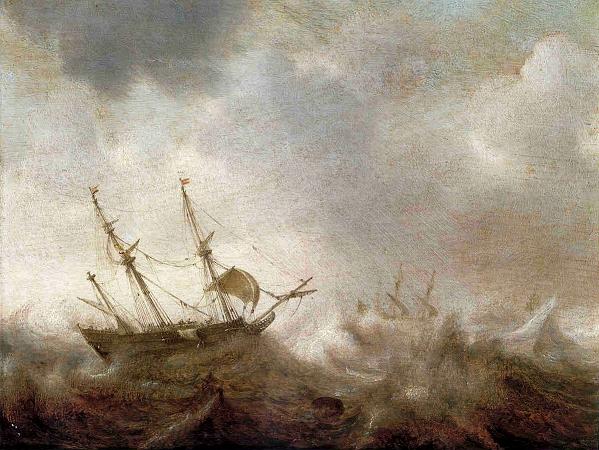Jan Porcellis (c1582 - 1632). Jan Porcellis was a Dutch marine artist in the seventeenth century. His works initiated a decisive transition from early realism to the tonal phase, fostering a new style and subject in marine painting by focusing on overcast skies and rough waters, a radical break from maritime art's previous focus on the grandeur of ships in historical settings. This style of greater simplicity surrounding maritime art, with the majority of the canvas displaying sea and sky, set the grounds for later works in this genre. Jan Porcellis was born at Ghent, around 1580 or 1584. Though his birth date can't be exactly determined, it can't be after 1584, since in that year his parents joined Protestants fleeing from Ghent, a city that had recently captured by Spaniards from the Northern Netherlands for a second time. He married in Rotterdam in 1605. His daughter was baptized in 1609 in Middleburg, and was an extensive traveler. According to Arnold Houbraken, Porcellis studied with Hendrick Vroom as a teacher, though this remains unproven. His early paintings date from 1612. His style became recognizable because of the use of many different light hues, exemplified in paintings such as Storm at Sea, which includes light effects previously unseen. Also notable from this period is Porcellis' rendition of Sea Battle at Night which, as its name indicates, features a marine conflict in dim light, with enemy ships barely visible and a gradual recognition of the subjects. By 1615, Porcellis faced financial constraints: he acquired three children, declared bankruptcy in Rotterdam and moved to Antwerp. Most of the paintings made in this period were serialized and sold in open markets; since they are not signed by Porcellis, they're considered lost. Thus, only about ten pictures from these years can be identified. Up to 1620, only about 10 works can be surely attributed to Porcellis, most of which represent battles, storms and harbor views. Prior to leaving Antwerp, the first wife of Porcellis died. In 1622, Porcellis moved to Haarlem with his three children, where he married Janneke Flessiers, daughter of Balthasar Flessiers. Porcellis continued the tradition of marine painting, but the setting of his pictures was never clarified and left ambiguous; this contrasted the usual style of contemporary marine painters, such as Jan Brueghel or Vroom, who traditionally portrayed Antwerp Harbour or the Spaarne at Haarlem. Porcellis' two years in Haarlem probably saw the beginning of his reputation and prosperity. He gained more popularity because of the detail in his paintings, particularly in portraying the Beach View of Haarlem, various of which were found scattered in other European places and palaces, such as Palazzo Venezia in Rome, or in the collection of the Emperor of Germany. In these years Porcellis' series of twenty etchings, Verscheyden Stranden en Water Gesichten, was published in Haarlem by Jan Pietersz. Porcellis soon left Haarlem and in 1624 was living in Amsterdam; by 1626 he had moved to Voorburg near The Hague. Around this time, in 1627, a set of twelve prints after Porcellis's designs were published in Amsterdam by C. J. Visscher, the Icones Variarum navium hollandicarum, the first 'iconography' of ship types since Pieter Bruegel's in 1565. At some time between 1627 and 1629 he moved more or less permanently to Zoeterwoude in the environs of Leiden. His last years were spent in prosperity thanks to his wife's share of the estate of her stepmother, and thanks also to sales of his pictures. On 19 December 1631, Porcellis lay 'ziekelijk te bedde' in his house in Zoeterwoude, and made his will; on 29 January 1632 he died. His widow was legatee, with a provision that the third child and only son, Julius, would receive all the paintings and works in the artist's possession at his death, to wit, those by the artist's hand and signed with his name, and no others. Jan Porcellis developed in the tradition of Dutch Marine Painting. Henrick Vroom, whom Houbraken claims was Porcellis' teacher, was skillful at ship-painting, covering subjects such as fish, fishermen and other boatmen. Porcellis' earliest paintings, of the period up till 1612, demonstrated that he had mastered Vroom's style which enjoyed much popularity at the time. The Storm at Sea by Porcellis, reflects many characteristics which were important in Vroom's era, both in terms of its theatrics and in its conventions of rendering. For all the perils he portrays, Porcellis puts less emphasis on spectacular destruction. The fact that no big ship wrecks are directly portrayed proves this point. The audience are rather invited to make out what happens gradually. Porcellis' ships sit has a solid presence in water and the grey hazy atmosphere contrasts and blurs the horizon and the ships in the distance.
more...













